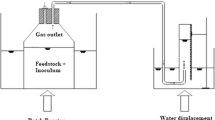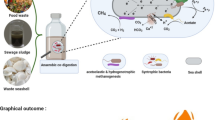Abstract
Fishery byproducts were acidogenically fermented with agricultural wastes (corncob, cabbage waste, and fruit peel), and fishery acidogenic fermentation broth (FFB) was used to observe sludge reduction and biogas production in anaerobic co-digestion. The experiment was conducted using a batch test for 30 days in mesophilic conditions. Samples with FFB showed a short response delay time of 1.50–3.06 (day), and total solid (TS) and volatile solid (VS) removal efficiencies of 23–43% and 20–30%, respectively, which were higher than those without FFB. In addition, the process produced 2.63–3.86 times more biogas with a methane content of over 70%. These results indicate that FFB improves the biodegradability of sewage sludge and that microbial communities were activated in a short time during the anaerobic co-digestion process. In particular, the highest TS and VS removal efficiency, biogas production, and high methane content were observed in FFB with corncobs. This suggests that nutrients such as sugar and minerals in corncobs may have positively affected the activity of methane-producing archaea. The anaerobic co-digestion process, which combines FFB and sewage sludge, enhanced the treatment efficiency of sludge and has an advantage of energy recovery.



Similar content being viewed by others
References
Aboudi, K., Álvarez-Gallego, C. J., & Romero-García, L. I. (2015). Semi-continuous anaerobic co-digestion of sugar beet byproduct and pig manure: effect of the organic loading rate (OLR) on process performance. Bioresource Technology, 194, 283–290.
Adarme, O. F. H., Baêta, B. E. L., Filho, J. B. G., Gurgel, L. V. A., & de Aquino, S. F. (2019). Use of anaerobic co- digestion as an alternative to add value to sugarcane biorefinery wastes. Bioresource Technology, 287, 121443.
APHA. (2012). Standard methods for the examination of water and wastewater. In E. W. Rice, R. B. Baird, A. D. Eaton, & L. S. Clesceri (Eds.), (22nd ed.). Washington, D.C.: American Public Health Association (APHA), American Water Works Association (AWWA) and Water Environment Federation (WEF).
ASTM D7833–14 (n.d.). Standard test method for determination of hydrocarbons and non-hydrocarbon gases in gaseous mixtures by gas chromatography, active standard ASTM D7833 | Developed by Subcommittee: D03.07. Book of Standards Volume: 05.06, https://www.astm.org/standards/d7833.html.
Cadavid-Rodrígueza, L. S., Vargas-Muñoza, M. A., & Plácido, J. (2019). Biomethane from fish waste as a source of renewable energy for artisanal fishing communities. Sustainable Energy Technologies and Assessments, 34, 110–115.
Chen, N., Zhang, G., Zhang, P., Tao, X., Wu, Y., Wang, S., & Nabi, M. (2019). Rice husk-based solid acid for efficient hydrolysis and saccharification of corncob. Bioresource Technology, 292, 121915.
Choi, H. J. (2020). Acid-fermented fish by-products broth: an influence to sludge reduction and biogas production in an anaerobic co-digestion. Journal of Environmental Management, 262, 110305.
Choi, H. J. (2021). Influence of acidogenic fermented fish by-products with rice bran for sludge reduction and biogas recovery in anaerobic co-digestion. Environmental Engineering Research, 26(1), 190409.
Choi, H. J., & Lee, S. Y. (2019). Advances in microalgal biomass/bioenergy production with agricultural by-products: analysis with various growth rate models. Environmental Engineering Research, 24(2), 271–278.
De Corato, U., De Bari, I., Viola, E., & Pugliese, M. (2018). Assessing the main opportunities of integrated biorefining from agro-bioenergy co/by-products and agroindustrial residues into high-value added products associated to some emerging markets: a review. Renewable and Sustainable Energy Reviews, 88, 326–346.
Di Maris, F., Sordi, A., Cirulli, G., & Micale, C. (2015). Amount of energy recoverable from an existing sludge digester with the co-digestion with fruit and vegetable waste at reduced retention time. Applied Energy, 150, 9–14.
Esteban-Gutiérrez, M., Garcia-Aguirre, J., Irizar, I., & Aymerich, E. (2018). From sewage sludge and agri-food waste to VFA: individual acid production potential and up-scaling. Waste Management, 77, 203–212.
Estevez, M. M., Sapci, Z., Linjordet, R., & Morken, J. (2014). Incorporation of fish by-product into the semi-continuous anaerobic co-digestion of pre-treated lignocellulose and cow manure, with recovery of digestate’s nutrients. Renewable Energy, 66, 550–558.
Fountoulakis, M. S., Petousi, I., & Manios, T. (2010). Co-digestion of sewage sludge with glycerol to boost biogas production. Waste Management, 30, 1849–1853.
Grosser, A., Neczj, E., Singh, B. R., Almas, A. R., BrattebØ, H., & Kacprzak, M. (2017). Anaerobic digestion of sewage sludge with grease trap sludge and municipal solid waste as co-substrates. Environmental Research, 155, 249–260.
Hidaka, T., Arai, S., Okamoto, S., & Ucida, T. (2013). Anaerobic co-digestion of sewage sludge with shredded grass from public green spaces. Bioresource Technology, 130, 667–672.
Hosseini, K. E., Barrantes, L. M., Eskicioglu, C., & Dutil, C. (2014). Mesophilic batch anaerobic co-digestion of fruit-juice industrial waste and municipal waste sludge: process and cost-benefit analysis. Bioresource Technology, 152, 66–73.
Ivanovs, K., Spalvins, K., & Blumberga, D. (2018). Approach for modelling anaerobic digestion processes of fish waste. Energy Procedia, 147, 390–396.
Kainthola, J., Kalamdhad, A. S., & Goud, V. V. (2016). Enhanced methane production from anaerobic co-digestion of rice straw and hydrilla verticillata and its kinetic analysis. Biomass and Bioenergy, 125, 8–16.
Kang, C. H., Yoon, E. K., Muthusamy, M., Kim, J. A., & Lee, S. I. (2020). Blue LED light irradiation enhances L-ascorbic acid content while reducing reactive oxygen species accumulation in Chinese cabbage seedlings. Scientia Horticulturae, 261, 108924.
Kim, J., Kim, H., Baek, G., & Lee, C. (2017). Anaerobic co-digestion of spent coffee grounds with different waste feedstocks for biogas production. Waste Management, 60, 322–328.
Latha, K., Velraj, R., Shanmugam, P., & Sivanesan, S. (2019). Mixing strategies of high solids anaerobic co-digestion using food waste with sewage sludge for enhanced biogas production. Journal of Cleaner Production, 210, 388–410.
Lemmer, A., Merkle, W., Baer, K., & Graf, F. (2017). Effects of high-pressure anaerobic digestion up to 30 bar on pH-value, production kinetics and specific methane yield. Energy, 138, 659–667.
Lyytimäki, J. (2018). Renewable energy in the news: environmental, economic, policy and technology discussion of biogas. Sustainable Production and Consumption, 15, 65–73.
Mshandete, A., Kivaisi, A., Rubindamayugi, M., & Mattiasson, B. (2004). Anaerobic batch co-digestion of sisal pulp and fish wastes. Bioresource Technology, 95(1), 19–24.
Mu, L., Zhang, L., Zhu, K., Ma, J., & Li, A. (2020). Anaerobic co-digestion of sewage sludge, food waste and yard waste: synergistic enhancement on process stability and biogas production. Science of the Total Environment, 704, 135429.
Nayak, A., & Bhushan, B. (2019). An overview of the recent trends on the waste valorization techniques for food wastes. Journal of Environmental Management, 233, 352–370.
Pan, Y., Zhi, Z., Zhen, G., Lu, X., Bakonyi, P., Li, Y. Y., Zhao, Y., & Banu, J. R. (2019). Synergistic effect and biodegradation kinetics of sewage sludge and food waste mesophilic anaerobic co-digestion and the underlying stimulation mechanisms. Fuel, 253, 40–49.
Seong, J. H., Park, S. G., Park, E. M., Kim, H. S., Kim, D. S., & Chung, H. S. (2006). Contents of chemical constituents in organic Korean cabbages. Korean Journal of Food Preservation, 13(5), 655–660.
Siddique, M. N. I., & Wahid, Z. A. (2018). Achievements and perspectives of anaerobic co-digestion: a review. Journal of Cleaner Production, 194, 359–371.
Stunzenas, E., & Kliopova, I. (2018). Optimizing municipal biodegradable waste management system to increase biogas output and nutrient recovery: a case study in Lithuania. Energy Procedia, 147, 641–648.
Vats, N., Khan, A. A., & Ahmad, K. (2019). Effect of substrate ratio on biogas yield for anaerobic co-digestion of fruit vegetable waste & sugarcane bagasse. Environmental Technology and Innovation, 13, 331–339.
Wei, Y., Li, F., Zhang, S., Zhang, S., & Sun, R. (2019). Characterization of interspecific hybrids between Chinese cabbage (Brassica rapa) and red cabbage (Brassica oleracea). Scientia Horticulturae, 250, 33–37.
Yenigün, O., & Demirel, B. (2013). Ammonia inhibition in anaerobic digestion: a review. Process Biochemistry, 48(5–6), 901–911.
Zhou, M., Yan, B., Wong, J. W. C., & Zhang, Y. (2018). Enhanced volatile fatty acids production from anaerobic fermentation of food waste: a mini-review focusing on acidogenic metabolic pathways. Bioresource Technology, 248, 68–78.
Acknowledgments
This study was supported by the Basic Science Research Program through the National Research Foundation (NRF) of Korea, funded by the Ministry of Education, Science and Technology (2019R1H1A280120).
CRediT Authorship Contribution Statement
Hee-Jeong Choi: Conceptualization, Methodology, Investigation, Software, Data curation, Writing—original draft, Visualization, Writing—review and editing.
Author information
Authors and Affiliations
Corresponding author
Ethics declarations
Competing Interest
The authors declare that they have no conflict of interest.
Additional information
Publisher’s Note
Springer Nature remains neutral with regard to jurisdictional claims in published maps and institutional affiliations.
Rights and permissions
About this article
Cite this article
Choi, HJ. Assessment of Sludge Reduction and Biogas Potential from Anaerobic Co-digestion Using an Acidogenically Fermented Fishery Byproduct with Various Agricultural Wastes. Water Air Soil Pollut 231, 336 (2020). https://doi.org/10.1007/s11270-020-04720-w
Received:
Accepted:
Published:
DOI: https://doi.org/10.1007/s11270-020-04720-w




